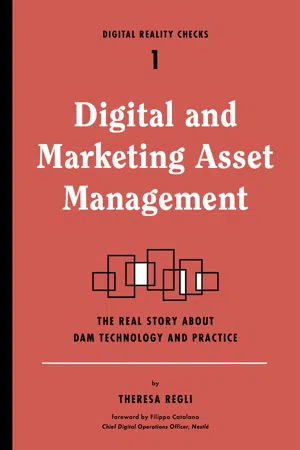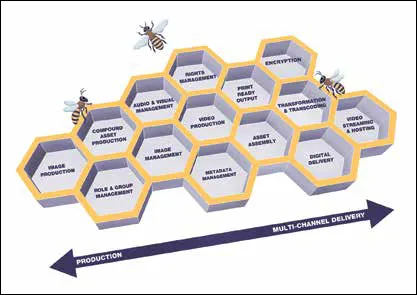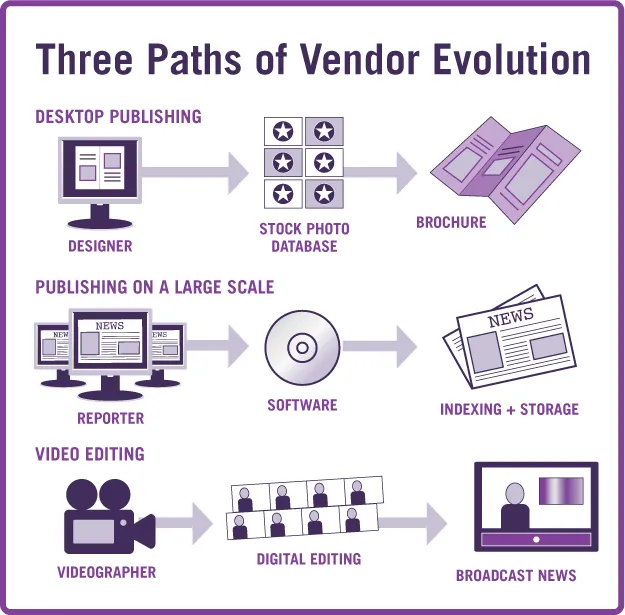
eBook - ePub
Digital and Marketing Asset Management
The Real Story about DAM Technology and Practices
- 240 pages
- English
- ePUB (mobile friendly)
- Available on iOS & Android
eBook - ePub
Digital and Marketing Asset Management
The Real Story about DAM Technology and Practices
About this book
The digital world is transitioning from text to media: photos, audio files, video clips, animations, games, and more. Enterprises of all kinds struggle with how to manage those media assets. Digital professionals who want to master the life cycles behind creating, storing, and reusing media need the inside scoop on how digital and media asset management technology really works.
Frequently asked questions
Yes, you can cancel anytime from the Subscription tab in your account settings on the Perlego website. Your subscription will stay active until the end of your current billing period. Learn how to cancel your subscription.
No, books cannot be downloaded as external files, such as PDFs, for use outside of Perlego. However, you can download books within the Perlego app for offline reading on mobile or tablet. Learn more here.
Perlego offers two plans: Essential and Complete
- Essential is ideal for learners and professionals who enjoy exploring a wide range of subjects. Access the Essential Library with 800,000+ trusted titles and best-sellers across business, personal growth, and the humanities. Includes unlimited reading time and Standard Read Aloud voice.
- Complete: Perfect for advanced learners and researchers needing full, unrestricted access. Unlock 1.4M+ books across hundreds of subjects, including academic and specialized titles. The Complete Plan also includes advanced features like Premium Read Aloud and Research Assistant.
We are an online textbook subscription service, where you can get access to an entire online library for less than the price of a single book per month. With over 1 million books across 1000+ topics, we’ve got you covered! Learn more here.
Look out for the read-aloud symbol on your next book to see if you can listen to it. The read-aloud tool reads text aloud for you, highlighting the text as it is being read. You can pause it, speed it up and slow it down. Learn more here.
Yes! You can use the Perlego app on both iOS or Android devices to read anytime, anywhere — even offline. Perfect for commutes or when you’re on the go.
Please note we cannot support devices running on iOS 13 and Android 7 or earlier. Learn more about using the app.
Please note we cannot support devices running on iOS 13 and Android 7 or earlier. Learn more about using the app.
Yes, you can access Digital and Marketing Asset Management by Theresa Regli in PDF and/or ePUB format, as well as other popular books in Computer Science & Digital Marketing. We have over one million books available in our catalogue for you to explore.
Information
CHAPTER 1

What Is Digital and Marketing Asset Management Technology?
The Blurring of Enterprise Lines
The Challenges of Rich Media
What Is an Asset?
Metadata
Digital and Marketing Asset Management Defined
DAM Technology Services
Ten Core Characteristics of a DAM System
The Rise of Lightweight DAM Offerings
Since the turn of the millennium, digital media—photos, audio files, video clips, animations, games, interactive ads, streaming movies, and experiential marketing—have become an increasingly significant part of our everyday experience. The combination of inexpensive, highly functional digital still and video cameras (even as part of mobile devices); increased network bandwidth; decreased storage costs; low-cost, high-performance processors; high-capacity, solid-state memory; affordable cloud services; and the requisite digital media infrastructure has laid the foundation for today’s vibrant electronic ecosystem. Whether you’re browsing the Web, listening to a song on an iPhone, watching a video on a tablet, opening a rich media email on your mobile device, or recording a TV series on a digital video recorder, you’re experiencing digital media.
This digital media expansion creates a challenge for consumers and enterprises alike. Consumers want to organize the experience and consumption of digital media files. They want to be able to find them, categorize them, use them when and where they want, and do all this across multiple devices.
Enterprises have a similar but much broader wish list. Of course, they want to be able to find their assets easily—whether for a historical archive or in service of current projects. Most often, they want to use digital media “products” to reach prospective buyers. They may use them as part of a marketing campaign to reach a specific audience in a specific form, such as a brochure, an email promotion, a movie trailer, or a website landing page. The digital media tool also could be the product itself—a music collection, streaming television series, video, electronic magazine, ebook, or catalog—that the enterprise must distribute in a variety of formats or forms.
To produce these products, you need to create, organize, find, and use pieces of digital media: images, graphics, photos, layout and design files, video segments, and audio files. In most cases, you need to add textual information like copy, descriptions, and product data. Finally, you have to put it all together in the right format within the specific production process or workflow. Upon completion, you’ll want to distribute and track all the product components, as well as any changes or versions over time. Also, you’ll want to know how the various audiences use or consume the product, in both digital and nondigital (for example, paper, CD, and DVD) formats. Additionally (if that were not enough), many digital files have restrictions and rights that must be monitored and respected.
Enterprises have a growing desire to manage the entire lifecycle of digital media. They want to manage each piece of the product independently of, or in addition to, managing the product. This requires a master file that can be transformed into different formats, depending on need and derivative works that are one representation and use of the master.
This management of digital media throughout its lifetime is the general domain of digital asset management (DAM).
Marketing asset management (MAM) often falls under the same rubric, and we’ll explore both in the context of DAM. It is against this background that the DAM discussion will begin.
PUNS
Puns on the term DAM are, unfortunately, one of the things you will need to get used to if you’re pursuing this discipline and technology.
Digital asset management as a discipline and a technology is all about the control, flexibility, portability, access, and reporting of digital assets (images, video, audio, and documents) among organizations, customers, partners, and suppliers. DAM is concerned with delivering the right content to the right people, on all devices (laptops, tablets, TV, and mobile) mostly in real time, with the ability to track and measure digital asset engagement across an enterprise and its potential global reach.
As illustrated in Figure 1.1, digital and marketing asset management is a complex discipline with many moving technological parts, involving not only process and technology but also the people who make the strategy and technology perform. These include a company sponsor, a DAM champion, a librarian (or two), and—most importantly—the stakeholders who will use the system (or not). Whenever possible, you should include those who will use the system to ensure that it meets their needs and that they are comfortable with the new technology. When the different pieces of the technology puzzle come together, it should operate like a humming hive, where the bees have everything they need to produce targeted and personalized digital experiences.

FIGURE 1.1
DAM—and more broadly, creative operations management—is a “hive” of different features and functions spanning production, management, and multichannel delivery.
DAM—and more broadly, creative operations management—is a “hive” of different features and functions spanning production, management, and multichannel delivery.
The origins of digital asset management date back to the early 1990s. DAM’s roots lie in image management, publishing, and video (see Figure 1.2). Early DAM vendors attempted to provide a common repository in which to store digital media files. Some vendors started on the desktop, providing a simple database or archive for cataloging and indexing digital images. In many cases, they were cataloging licensed or stock photographs used in brochures or other publications.
Other DAM vendors started in the publishing arena by offering a repository for storing all the files for a particular publishing product, such as a book or magazine. These early functions were dominated by “creatives,” who used desktop publishing applications, such as QuarkXPress, Aldus PageMaker (remember those two?), or Adobe’s InDesign, and related photo-editing software, such as Adobe Photoshop or Illustrator.

FIGURE 1.2
Those tools that are now considered DAM tools evolved from three different origins.
Those tools that are now considered DAM tools evolved from three different origins.
A third group of vendors attempted to support digital video or time-based asset workflows. At the time, digital video editing was a new technology. It allowed video editors to cut and paste video digitized from tape or “ingested” directly from a live broadcast rapidly and more easily, together with other video, and create entirely new content from the combination. This technology reduced time and cost while increasing flexibility and creativity. This use of DAM coupled the DAM repository with the production or broadcast workflow. It also integrated with pioneering (though proprietary) digital video editors from companies like Avid and Pinnacle, as well as with VCRs, playout devices, schedulers, and other broadcast hardware.
This three-pronged origin originally made DAM products fragmented and specialized within the “DAM” umbrella. These lines are blurring as vendors add functionality to reach into areas outside their original domains. Still, DAM products come in many forms, and the most modern waves of new vendors are “born digital”; thus, they are more difficult to wedge into one of the three categories. Some are good at managing particular kinds of media. Others focus on particular use cases, workflows, or processes. The mix of vendors and products you’ll find in the marketplace today is varied, with these new “born digital” vendors competing with vendors and products that can trace their roots either directly or indirectly to these first-generation products.
The Blurring of Enterprise Lines
As recently as 2012, it was easy to segment vendors by category, such as “enterprise” or small- to medium-sized workgroup tools. “Enterprise capability” was measured based on scale, integration capability, global footprint, and large clients with global reach. Some of these classifications remain true; however, the advent of the cloud and the breadth of APIs (even among smaller vendors) have blurred the lines between historical “enterprise” vendors and the rest.
Adoption of the gargantuan server farms from the likes of Amazon, Google, Rackspace, and Microsoft (Azure) has been slow but is increasing. Cloud-based pricing from these technology behemoths has kept the landscape competitive, less intimidating, and easier to adopt. Any business can scale rapidly up or down as the need requires in the cloud.
DAM technology is now born in the cloud, or the vendor offers on-premise and cloud-based applications, services, and software-as-a-service (SaaS) environments. Increasingly, cloud-based technology is applied for cold storage archiving. Archives in the cloud would have been unthinkable a few years ago, but tumbling prices and cold storage are bringing archives into real time. A need exists for strong strategies to match, as well as have systems for the full lifecycle of assets, from creation to archive.
This book will deepen your understanding of DAM and help clarify how you will use this technology. We will arm you with the knowledge of how to ask the right questions so that you can create a DAM environment that will achieve your business goals.
The Challenges of Rich Media
Over the past few years, DAM has become an increasingly mainstream and core enterprise application. Conferences, journals, and even informal (but structured) “meet-ups” attest to the growth of DAM. Despite digital asset management being one of the fastest-growing marketing technologies, it may be the least understood.
DAM technology focuses on managing digital, or “rich,” media stored in files.
Originally, “rich media” meant anything that wasn’t purely text. It also referred to the depth or amount of information contained in the content itself. For example, a video contains visual and oral information; as such, a computer may have difficulty managing the content without human assistance. Examples of rich media include digital forms of images, video, audio, graphics, animations, artwork, games, CAD documents, PowerPoint presentations, or combinations of any of these. Rich media can include created or generated documents (as compared to scanned documents) that are highly structured, have defined page layouts, and contain or reference other c...
Table of contents
- Cover Page
- Title Page
- Copyright Page
- Contents
- How to Use This Book
- Foreword
- Introduction
- Chapter 1: What Is Digital and Marketing Asset Management Technology?
- Chapter 2: The Business Case for Digital and Marketing Asset Management
- Chapter 3: The DAM Maturity Model
- Chapter 4: DAM Technology Services: Asset Creation and Management
- Chapter 5: DAM Technology Services: Search, Retrieval, and Navigation
- Chapter 6: DAM Technology Services: Asset Assembly and Delivery
- Chapter 7: DAM Technology Services: Architecture and Administration
- Chapter 8: Cloud, On-Premise, or Hybrid? DAM Delivery Models
- Chapter 9: You’re Not Just Buying a Tool: Strategic Considerations
- Chapter 10: Universal Scenarios: The Key to Comparing Technologies
- Chapter 11: Mixology: DAM in the Digital Marketing Cocktail
- Index
- Acknowledgments
- About the Author